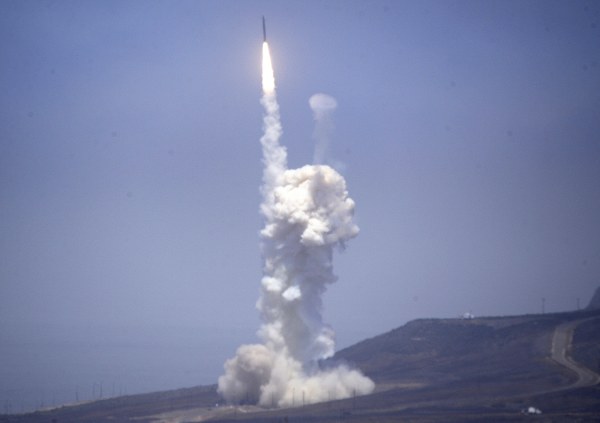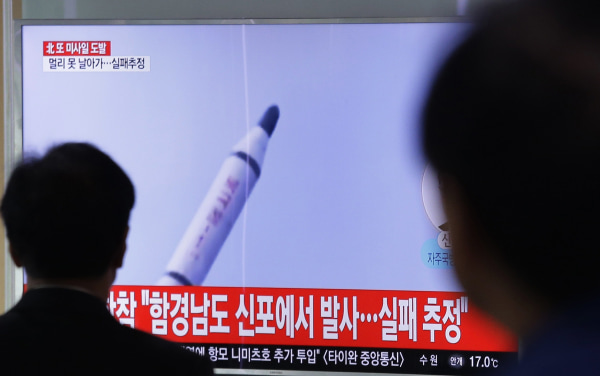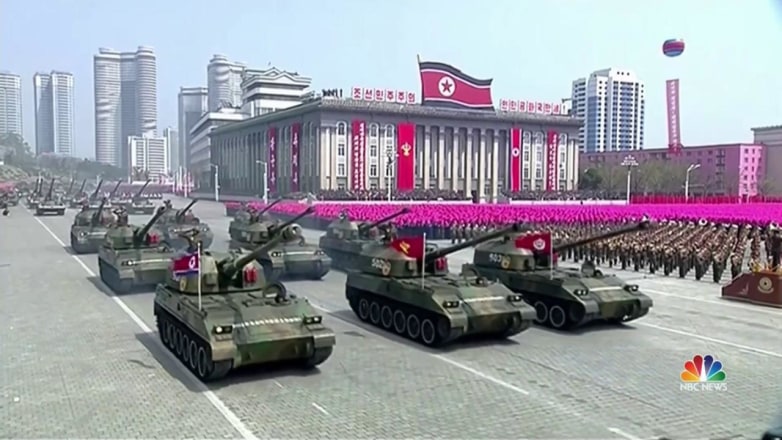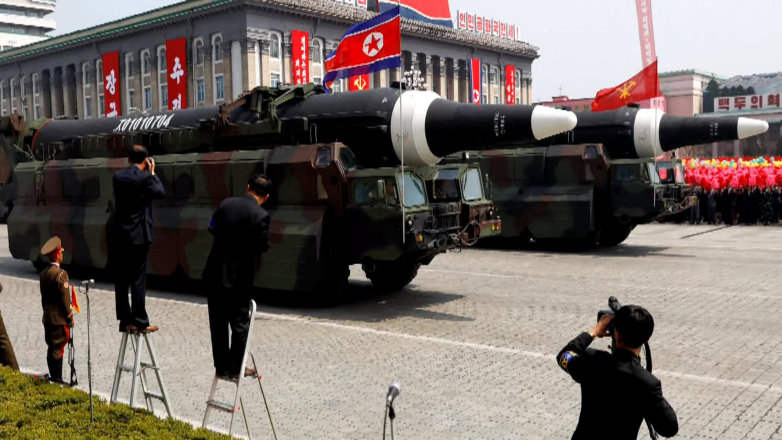U.S. May Not Be Able to Shoot Down North Korean Missiles, Say Experts
Top generals have been insisting for years that if North Korea launched a missile at the United States, the U.S military would be able to shoot it down.
But that is a highly questionable assertion, according to independent scientists and government investigators.
In making it, the generals fail to acknowledge huge questions about the effectiveness of the $40 billion missile defense system they rely on to stop a potential nuclear-armed ballistic missile fired by North Korean or Iran, according to a series of outside reviews.
"They are leading political leaders to believe that they have a military capability that they don't, in fact, have," says physicist David Wright, who has studied the program for years as co-director of the Global Security Program at the Union of Concerned Scientists.
Chris Johnson, a spokesman for the Pentagon's Missile Defense Agency, said the Pentagon "is confident in our ability to defend the homeland against ballistic missile threats." While the program had reliability challenges early in its development, "we have made significant improvements over the last several years to ensure the system is able to operate as designed," he added.
The missile defense system relies on 60-foot-tall, three-stage rockets of its own to knock the enemy projectiles out of space, a task that has been compared to shooting a bullet with a bullet. The system is known as the Ground-based Midcourse Defense system, or GMD.
There are 36 interceptors in operation, according to the Missile Defense Agency — four at Vandenberg Air Force Base in California and 32 at Ft. Greely, Alaska. Eight more are due online by year's end. In contrast to the Iron Dome system in Israel, which is designed to counter shorter range missiles and artillery, the GMD is made to hit missiles above the earth's atmosphere — a more difficult proposition. It is among the heirs to the Strategic Defense Initiative, the so-called Star Wars program launched under Ronald Reagan.
The missiles are based in Alaska and California because the West Coast is the best place from which to intercept missiles that would travel the shortest routes from both Iran and North Korea. Congress has pushed for a third site on the East Coast.

Intelligence agencies don't assess that North Korea is yet capable of firing a nuclear-armed missile at the U.S., but analysts believe it is on course to reach that goal.
But even though the system has been fielded, it hasn't been proven to work.
Last year, the Government Accountability Office, the investigative arm of Congress, concluded that the agency that runs the missile defense system "has not demonstrated through flight testing that it can defend the U.S. homeland."
In nine simulated attacks since the system was deployed in 2004, interceptors have failed to take out their targets six times, even though the flight tests were far less challenging than an actual attack, according to The Los Angeles Times, which published an investigation of the missile defense system last year that uncovered a previously unknown test failure.
"Despite years of tinkering and vows to fix technical shortcomings, the system's performance has gotten worse, not better," The Times concluded.
Last July, the highly regarded Union of Concerned Scientists, which is often skeptical of military programs, weighed in with a 47-page report calling the U.S. approach to missile defense "disastrous." Of the GMD, it concluded: "Its test record is poor and it has no demonstrated ability to stop an incoming missile under real-world conditions."
A 2012 National Academy of Sciences study called the GMD "deficient" and recommended a complete overhaul of the interceptors, sensors, and concept of operations. No such overhaul has happened.
A senior Congressional aide who regularly receives classified briefings on the system told NBC News Tuesday: "None of this stuff works reliably. Nothing. Their interceptor programs are not working. They shoot down targets some of the time, but it's not reliable enough that we would want to risk the catastrophic failure of a miss."
The Pentagon and its Missile Defense Agency strongly disagree. Officials have repeatedly assured lawmakers and the public that the system, despite its testing failures, is up to the task of protecting the United States.
"Today we have exactly what we need to defend the United States of America against North Korea," Air Force Gen. Lori Robinson, commander of the U.S. Northern Command, told the Senate Armed Services Committee on April 6.
Sen. Lindsey Graham asked: "So if a missile were launched from North Korea in the next year we could knock it down?"
"Yes sir," Robinson replied.
There is no basis for such certainty, Wright and other experts say.
The Pentagon has spent more than $40 billion to field a system that has not been proven in a real world scenario.
The system has failed about half the time in tests that are scripted, Wright says — meaning those operating the missile defense system have information about the target they would not have in real life. In 2002, the program was exempted from normal testing and procurement standards so that it could be deployed faster.
The system has still not been tested against realistic targets such as tumbling warheads, warheads accompanied by credible decoys, or warheads traveling at speeds and from distances similar to that of incoming intercontinental ballistic missiles (ICBMs)," the Union of Concerned Scientists report said. "Nearly 15 years after the GMD system was put on the fast track, the Pentagon's own testing officials have said the system has not demonstrated an operationally useful capability to defend the U.S. public from a missile attack."
Johnson, the missile agency spokesman, disputed that, asserting that the system had relied on "operationally realistic intercept tests."

Military officials have acknowledged that the technology is not where they would like it to be. One of the ways they would seek to improve their odds is to fire four or five interceptors at any one missile, under what is known as "shot doctrine."
"Today the shot doctrine, or number of (interceptors) launched at one incoming long range ballistic missile to ensure success, would be a high number," says the Missile Defense Advocacy Alliance, a group of contractors that build the systems, on its web site.
However, the Union of Concerned Scientists has calculated that if five warheads were headed to the U.S., and each interceptor had a 50 percent chance of hitting its target, there would be a 28 percent chance that one warhead would get through. Those are not odds a president would want to rely on in the case of a nuclear weapon.
Moreover, those odds leave aside the potential use of decoys and countermeasures, which has bedeviled missile defense for years. The GMD relies on heat sensors to distinguish between the real warhead and decoys, Wright said, but that could be defeated by something as simple as using liquid nitrogen to cool the warhead before launch.
Supporters of the program argue that failed tests are part of the learning process.
"In the space business, that's how you go fast," said Air Force Gen. John Hyten, commander of U.S. Strategic Command, in a recent appearance before Congress.
"Von Braun, in the early days of the rocket business, he had a 60 percent failure rate; maybe the greatest rocket scientist of all time," he added, referring to German scientist Wernher von Braun, who is credited with inventing the V-2 rocket for Nazi Germany before being secretly spirited to the U.S., where he developed the Saturn V, which propelled the Apollo spacecraft to the moon.
But the problem, Wright and other critics say, is that the generals aren't leveling with Congress and the American people about the uncertain state of the current technology. And they are spending billions fielding a system that may not work.
"More money to buy more bad stuff is not the answer," the senior Congressional aide said. "More for research and development is the answer."



No comments:
Post a Comment